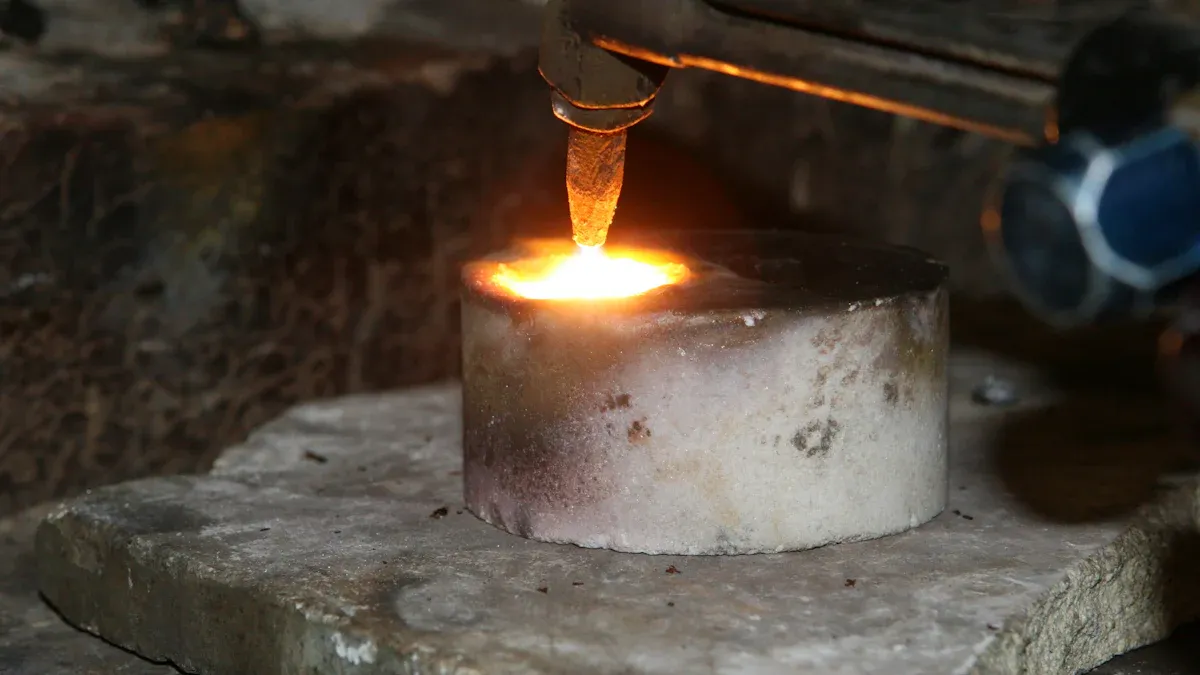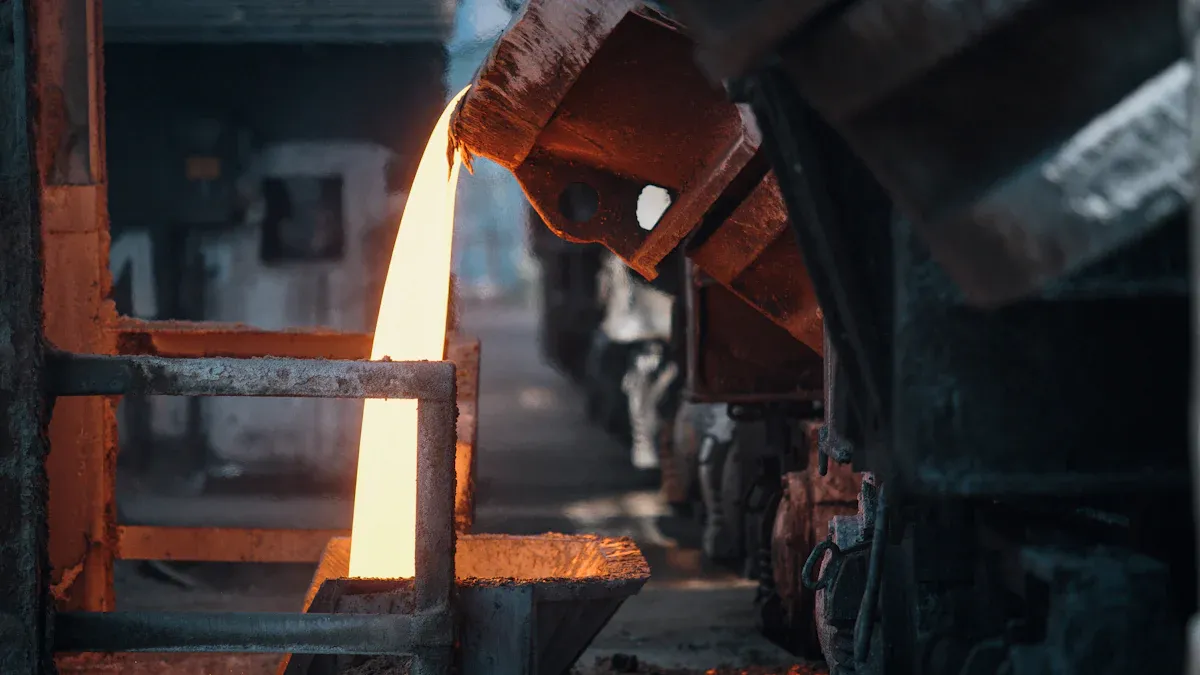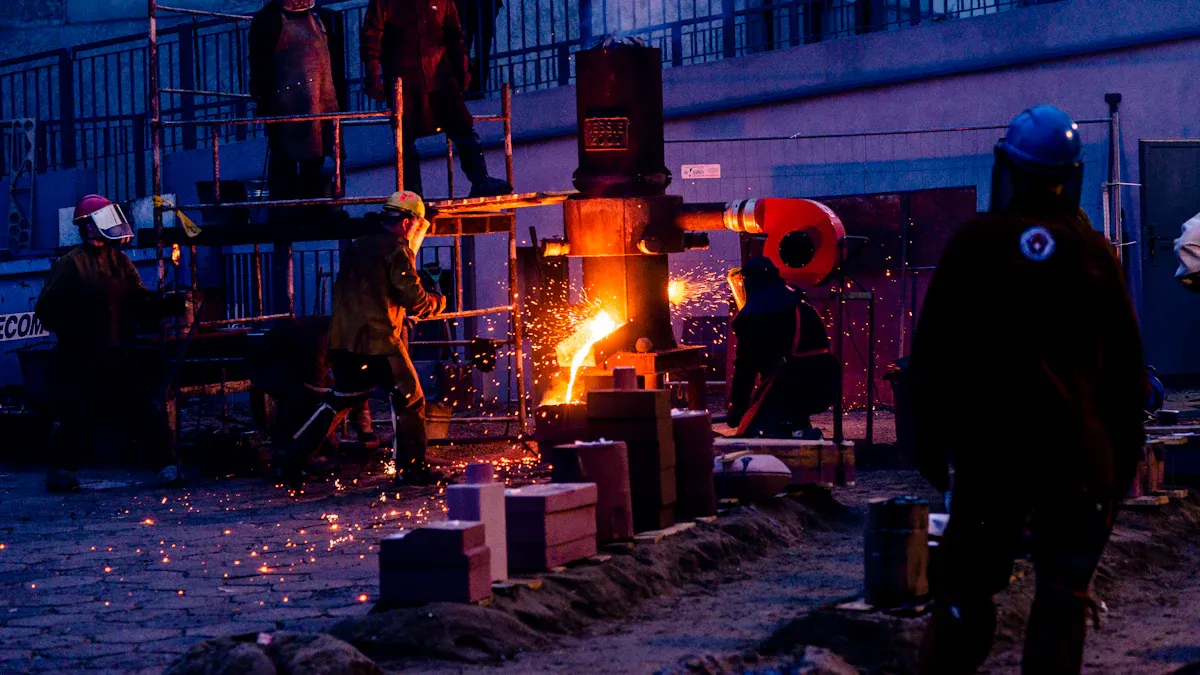
Tin bronze precision castings for steam boiler components redefine performance in industrial environments. These tin bronze steam boiler components offer exceptional corrosion resistance, ensuring durability even in challenging steam conditions. They excel at transferring heat due to their superior thermal conductivity, while their mechanical strength withstands stress, making them reliable in demanding operations. Tin bronze precision castings and tin bronze precision components truly set the standard for quality and efficiency.
Key Takeaways
- Tin bronze parts don’t rust easily, lasting longer in steam.
- They transfer heat well, making boilers work better and faster.
- Tin bronze is strong, handling high pressure and heat without breaking.
Properties of Tin Bronze Precision Castings for Steam Boiler Components

Corrosion Resistance in Steam Environments
Steam boiler components often operate in environments where moisture and high temperatures create the perfect conditions for corrosion. Tin bronze precision castings for steam boiler components excel in these settings. Their natural resistance to oxidation and corrosion ensures that they maintain their integrity over time. This property reduces the need for frequent replacements, saving both time and money.
Unlike materials like steel, which can rust or degrade in moist conditions, tin bronze forms a protective oxide layer. This layer acts as a barrier, preventing further damage. For industries relying on steam boilers, this means fewer interruptions and more reliable performance.
Superior Thermal Conductivity for Efficient Heat Transfer
Efficient heat transfer is critical in steam boiler operations. Tin bronze precision castings for steam boiler components stand out due to their excellent thermal conductivity. This property allows them to transfer heat quickly and evenly, improving the overall efficiency of the boiler system.
To better understand this, let’s look at the thermal properties of C86200, a common tin bronze alloy:
| Property | Description |
|---|---|
| Thermal conductivity | C86200 has a high thermal conductivity, making it an excellent conductor of heat. |
| Thermal expansion | C86200 has a low coefficient of thermal expansion, allowing it to withstand thermal stresses. |
| Melting point | C86200 has a relatively low melting point of approximately 1000°C, facilitating casting. |
| Specific heat capacity | C86200 has a moderate specific heat capacity, enabling efficient heat storage and release. |
| Thermal stability | C86200 maintains its properties under high temperatures for extended periods. |
These characteristics make tin bronze an ideal choice for steam boiler components. Its ability to handle thermal stresses ensures consistent performance, even under extreme conditions.
High Mechanical Strength for Durability Under Stress
Steam boilers operate under intense pressure and high temperatures, which can strain their components. Tin bronze precision castings for steam boiler components offer exceptional mechanical strength, making them highly durable. They resist deformation and wear, even when subjected to heavy loads or continuous use.
Laboratory tests highlight the impressive strength of tin bronze alloys:
| Property | Metric | Imperial |
|---|---|---|
| Hardness, Brinell | 72 | 72 |
| Tensile strength | 304 MPa | 44100 psi |
| Yield strength (@strain 0.500%) | 140 MPa | 20300 psi |
| Compressive strength (at permanent set of 10%) | 275 MPa | 39900 psi |
| Elastic modulus | 117 GPa | 16969 ksi |
These metrics demonstrate why tin bronze components are trusted in demanding applications. Their ability to withstand stress ensures long-term reliability, reducing the risk of unexpected failures.
Key Points:
- Tin bronze resists corrosion, making it ideal for steam environments.
- Its superior thermal conductivity enhances heat transfer efficiency.
- High mechanical strength ensures durability under pressure and stress.
Performance of Tin Bronze in Steam Boiler Applications
Resistance to High Temperatures and Pressures
Steam boilers operate in extreme conditions, where both high temperatures and pressures are constant challenges. Tin bronze precision castings for steam boiler components excel in these environments. Their unique composition allows them to maintain structural integrity even when exposed to intense heat and pressure. This makes them a reliable choice for industries that demand consistent performance.
Studies have shown that tin bronze alloys exhibit enhanced erosion-corrosion resistance. This property ensures that the material can withstand the combined effects of heat, pressure, and corrosive steam environments. Unlike other materials that may weaken or deform under such conditions, tin bronze remains stable and durable.
For example:
- Tin bronze alloys resist thermal expansion, reducing the risk of cracking or warping.
- Their ability to endure high-pressure environments ensures safety and reliability in boiler operations.
This combination of heat and pressure resistance makes tin bronze components indispensable in steam boiler systems.
Longevity and Reliability in Continuous Operation
Steam boilers often run for extended periods without interruption. This continuous operation places significant stress on their components. Tin bronze precision castings for steam boiler components stand out due to their exceptional longevity and reliability.
The material’s natural resistance to wear and corrosion ensures that it performs consistently over time. Tin bronze components require less frequent maintenance or replacement, which reduces downtime and operational costs. Industries benefit from this reliability, as it minimizes disruptions and enhances productivity.
Moreover, tin bronze’s mechanical strength plays a crucial role in its durability. It resists deformation and maintains its shape, even under heavy loads or prolonged use. This makes it a preferred choice for critical applications where failure is not an option.
Real-World Example: Tin Bronze Precision Castings in Industrial Boilers
Industrial boilers are a prime example of how tin bronze precision castings deliver unmatched performance. In these systems, components like bearings, bushings, and fittings must endure harsh conditions. Tin bronze proves to be the ideal material for these parts.
For instance, a power plant using tin bronze precision castings for its boiler components reported significant improvements in efficiency and reliability. The components showed minimal wear after years of operation, highlighting their durability. Additionally, the plant experienced fewer maintenance issues, leading to cost savings and increased uptime.
This real-world application demonstrates the value of tin bronze in demanding environments. Its ability to perform under pressure, resist corrosion, and last for years makes it a top choice for industrial boilers.
Key Points:
- Tin bronze precision castings for steam boiler components resist high temperatures and pressures, ensuring safety and reliability.
- Their longevity and reliability reduce maintenance needs and operational costs.
- Real-world examples highlight their effectiveness in industrial boiler systems.
Advantages of Tin Bronze Over Other Materials
Comparison with Steel and Cast Iron in Corrosive Conditions
Tin bronze outperforms steel and cast iron in environments prone to corrosion. Steam boilers often operate in moist, high-temperature conditions that accelerate rust and material degradation. Steel and cast iron, while strong, are vulnerable to oxidation. Tin bronze, on the other hand, forms a protective oxide layer that shields it from further damage. This natural barrier ensures long-lasting performance, even in the harshest environments.
For industries relying on steam boilers, this means fewer replacements and reduced maintenance costs. Tin bronze components also maintain their structural integrity better than steel or cast iron, making them a more reliable choice for critical applications.
Superior Longevity Compared to Aluminum Alloys
Aluminum alloys are lightweight and cost-effective, but they fall short in durability compared to tin bronze. Steam boiler components made from aluminum alloys often wear out faster due to their lower mechanical strength and susceptibility to corrosion. Tin bronze, with its superior hardness and resistance to wear, offers a longer service life.
The composition of tin bronze plays a key role in its longevity. Alloys with 15-20% tin content achieve optimal toughness, while the remaining copper ensures excellent thermal and mechanical properties. This balance makes tin bronze components ideal for continuous operation in demanding environments.
Case Study: Tin Bronze Bearings vs. Alternative Materials
A comparison of tin bronze bearings with other materials highlights its advantages in high-demand settings. The table below illustrates the performance of various materials under different load ranges:
| Material Type | Wear Rate | Hardness | Friction Temperature | Load Range (N) |
|---|---|---|---|---|
| Aluminum Bronze 9-4 | N/A | N/A | N/A | 100, 200, 300, 400, 500 |
| Aluminum Bronze ISSLB | N/A | N/A | N/A | 100, 200, 300, 400, 500 |
| Tin Bronze 663 | N/A | N/A | N/A | 100, 200, 300, 400, 500 |
| Tin Bronze 663 ISSLB | N/A | N/A | N/A | 100, 200, 300, 400, 500 |
Tin bronze bearings consistently demonstrate lower wear rates and better performance under high loads. Their ability to withstand friction and maintain stability under stress makes them a preferred choice for industrial applications.
Key Points:
- Tin bronze resists corrosion better than steel and cast iron, ensuring durability in harsh environments.
- Its superior longevity outshines aluminum alloys, reducing the need for frequent replacements.
- Case studies show tin bronze bearings excel in high-demand settings, offering unmatched reliability.
How Precision Casting Enhances Tin Bronze Components

Improved Dimensional Accuracy and Surface Finish
Precision casting plays a vital role in enhancing the quality of tin bronze components. This process ensures exceptional dimensional accuracy, which is critical for steam boiler parts that require a perfect fit. By using advanced techniques, manufacturers can achieve tight tolerances, reducing the need for additional machining.
The surface finish of precision-cast tin bronze components also stands out. Smooth surfaces minimize friction and wear, extending the lifespan of parts like bearings and bushings. For example, a polished tin bronze fitting not only performs better but also resists corrosion more effectively. This combination of accuracy and finish ensures that components meet the high standards required in industrial applications.
Enhanced Performance Through Customization
Customization in precision casting allows manufacturers to tailor tin bronze components to specific needs. This flexibility has revolutionized the performance of steam boiler parts. Popular customization options include:
- Special Chamfers: Improve the fit and reduce wear.
- Grooves: Enhance lubrication and extend the lifespan of moving parts.
- Rings: Provide better alignment and stability.
- Surface Treatments: Boost durability and overall performance.
Quality control ensures that these customizations meet industry standards. Foundries use rigorous testing methods, such as non-destructive testing, to detect internal flaws. This attention to detail guarantees that every customized component delivers reliable performance.
Example: Precision-Cast Tin Bronze Fittings in Power Plants
Power plants rely heavily on precision-cast tin bronze fittings for their steam boiler systems. These fittings must endure high temperatures, pressure, and corrosive environments. Precision casting ensures that each fitting meets these demands.
For instance, a power plant that switched to customized tin bronze fittings reported fewer maintenance issues and improved efficiency. The fittings’ enhanced durability and perfect fit reduced downtime, saving both time and money. This real-world example highlights how precision casting elevates the performance of tin bronze components in critical applications.
Key Points:
- Precision casting improves dimensional accuracy and surface finish, ensuring better performance and durability.
- Customization options like grooves and surface treatments enhance functionality and lifespan.
- Real-world applications in power plants demonstrate the reliability of precision-cast tin bronze components.
Tin bronze precision castings for steam boiler components deliver unmatched performance in demanding environments. Their corrosion resistance, supported by a protective oxide layer, ensures durability even in harsh conditions. The material’s excellent wear resistance and fatigue strength make it ideal for industrial applications, reducing maintenance needs. Precision casting enhances these components further, offering superior dimensional accuracy and customization options. This combination of properties guarantees reliability, efficiency, and longevity, making tin bronze the top choice for steam boiler systems.
Key Points:
- Tin bronze resists corrosion and wear, ensuring long-lasting performance.
- Precision casting improves accuracy and functionality, meeting industrial demands.
- These components excel in high-temperature, high-pressure environments.
FAQ
What makes tin bronze better than other materials for steam boiler components?
Tin bronze offers superior corrosion resistance, thermal conductivity, and mechanical strength. These properties ensure durability and efficiency in demanding steam environments.
How does precision casting improve tin bronze components?
Precision casting enhances dimensional accuracy and surface finish. It also allows for customization, ensuring components meet specific industrial requirements.
Can tin bronze components handle extreme temperatures and pressures?
Yes! Tin bronze maintains its integrity under high temperatures and pressures, making it ideal for steam boiler systems.
Tip: Always consult with a trusted manufacturer, like Ningbo Pingheng Machinery Co., Ltd., for high-quality tin bronze precision castings tailored to your needs.
